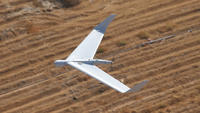-
Laser-powered, ground-charged UAV stays aloft for hours

A UAV is only as good as its power source: if the drone cannot stay over target for long periods of time and must return to base to refuel, this not only adds to the costs of operating the drone but it also degrade its intelligence gathering capabilities; Seattle-based company demonstrates that it can use a laser beam to charge the UAV’s photovoltaic cells, generating enough power to keep the drone in the air for hours; the company has bigger plans for extending flight duration of military craft — and much more: in the longer term, it envisions lasers powering remote ground-based sensors, delivering power to forward military bases, or supplying emergency power during disasters
-
-
Six UAVs to patrol border from California to Texas
DHS secretary Janet Napolitano said that by the beginning of next year, the number of UAVs operating along the U.S.-Mexico border would be up to six, providing “critical aerial surveillance assistance”; previously, drones were not approved by the Federal Aviation Administration (FAA) for use in a stretch of west Texas
-
-
Shape-shifting UAV for maritime search and rescue missions
Use of morphing flight surfaces has enabled the development of a shape-shifting UAV that can operate in extreme weather conditions; cutting-edge avionics ensure a smooth flight for extended rescue and surveillance missions, while reducing risks to material and crews
-
-
Mexico deploys Israeli UAVs in war on drug cartels

Since December 2006, nearly 30,000 Mexicans have been killed in that country’s increasingly vicious drug war; the relentless flow of guns from the United States into Mexico has significantly strengthened the drug cartels, allowing them not only to withstand the efforts by the Mexican authorities to impose law and order, but in many cases to take the operational initiative, making large swaths of the country ungovernable; the Mexican government, for its part, is bolstering its own capabilities: last year it has secretly purchased surveillance UAVs from Israel to perform monitoring tasks in border areas and near strategic installations in the country
-
-
Border Patrol to buy two new UAV for U.S.-Mexico border
Just-passed border bill includes $32 million to buy two new Predator B turboprop UAV aircraft from General Atomics, as well as fund operating control stations for them; retired Air Force Maj. Gen. Michael Kostelnik, the assistant Customs and Border Protection commissioner for the Office of Air and Marine, told a House subcommittee that twenty-four UAVs would eventually be needed to cover the entire northern and southern borders and U.S. coastlines
-
-
U.S. swarm satellites will scatter to avoid space-war strikes
Many aspects of active space warfare — including attack on another nation’s spacecraft — is strictly forbidden by international law and treaty, but the United States intends to be ready for it anyway; new “fractionated” swarm satellites will see groups of small wirelessly linked modules in orbit replacing today’s large spacecraft; the swarm will be able to scatter to avoid enemy attacks and then reform into operational clusters
-
-
High-altitude surveillance UAV completes maiden voyage
The first flight of a stratospheric unmanned aircraft — the Global Observer — designed to provide uninterrupted surveillance over any point on the globe was completed successfully; the company’s CEO says that in the 20th century, conventional airplanes opened the lower atmosphere to practical use and satellites did the same for space — “Global Observer soon will establish the stratosphere as a valuable and practical area of operation”
-
-
Autogyro airborne surveillance vehicle for law enforcement, military unveiled
The two-seater Scorpion S3 autogyro has been designed for the law enforcement and intelligence, surveillance, and reconnaissance (ISR) markets; the Scorpion S3 uses an unpowered rotor in autorotation to develop lift, and a gas turbine Alison B17 engine-powered propeller to provide thrust; the design will reduce costs for fleet operators by 75 percent while also reducing their carbon footprint by up to 80 percent compared to a conventional medium-sized gas turbine helicopter
-
-
UAVs fail to penetrate India's dense forests to track Maoist militants

Indian security forces, battling the militants of the Naxals Maoist group, say that UAVs which perform well in the deserts of Iraq and the barren mountains of Afghanistan and Pakistan, are useless in the densely forested areas of eastern India; Indian security experts say that issues concerning internal security in the country have now reached the board room of Indian business companies and that the new technology these companies produce should be able to meet the specific needs of Indian security forces rather than offer something which is not applicable to Indian conditions
-
-
Watchkeeper surveillance drone "can see footprints through cloud"
Thales UK’s Watchkeeper surveillance UAV is fitted with radar so sensitive, according to its makers, that it can detect not only individual people moving about on the ground — but even the footprints they leave in the dirt; Watchkeeper is a modified version of the Israeli Hermes 450 with added French and British bits and pieces
-
-
UAVs perform autonomous search-and-rescue operations
Researchers developed sophisticated search algorithms which allow UAVs autonomously to analyze the terrain and use probabilistic models to determine a lost person.s likely route; the UAVs will make searching for lost people much cheaper, faster, and safer than using helicopters
-
-
Increased use of UAVs in border protection hobbled by shortage of UAV pilots
As hopes that SBInet, the ambitious virtual fence project along the U.S.-Mexico border, will ever live up to its promise recede, DHS has increased the role of UAVs in border monitoring; UAVs require pilots to fly them remotely, though, and Customs and Border Protection (CBP) has had trouble finding trained pilots remotely to fly the aircraft; Maj. Gen. Michael Kostelnik, assistant commissioner of CBP’s Air and Marine Office: “The greatest near-term challenge faced is a shortage of pilots and sensor operators, specifically pilots certified to launch and land the aircraft”
-
-
Blimps may replace cargo planes within ten years
Airships would be too slow for some high-speed airfreight, and would not be needed to carry the majority of cargo for which much slower ships are suitable, but with a speed of 125 kph (78 mph), and much lower fuel costs, plus a carrying capacity potentially many times that of a standard Boeing 747 plane, blimps could in future carry much of current air freight
-
-
U.S. Navy blimp to help track oil flow in gulf
A U.S. Navy blimp arrived in the Gulf of Mexico yesterday to help detect oil, direct skimmers, and search for threatened wildlife; the blimp can carry as many as ten crew members as it flies slowly over the region to track the direction of the oil flow and how it is washing ashore
-
-
Tiny flying robots to monitor forest-fires, chemical spills, and more
Swiss researchers developed a tiny flying robot which could be equipped with different sensors and small cameras for a variety of applications; the robot could monitor different kinds of emergencies — from forest fires to chemical accidents
-